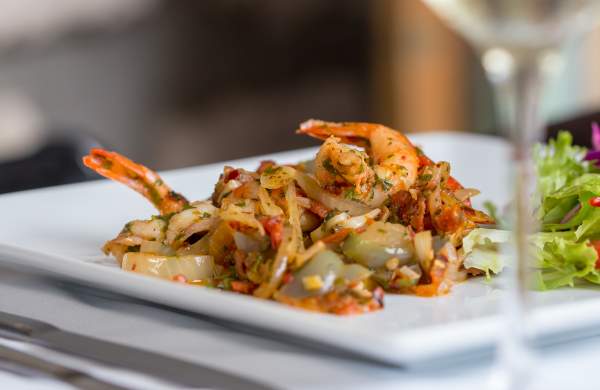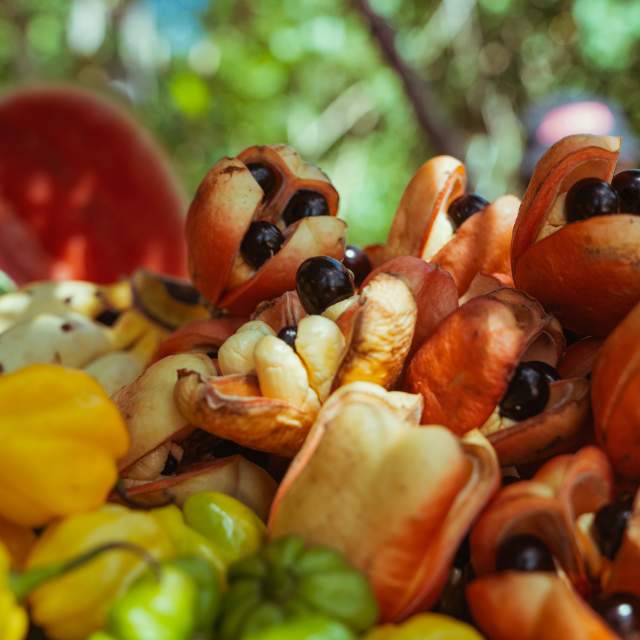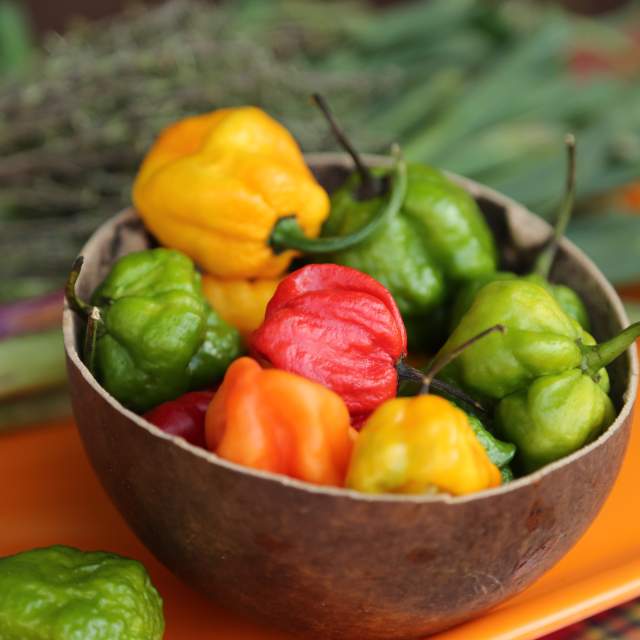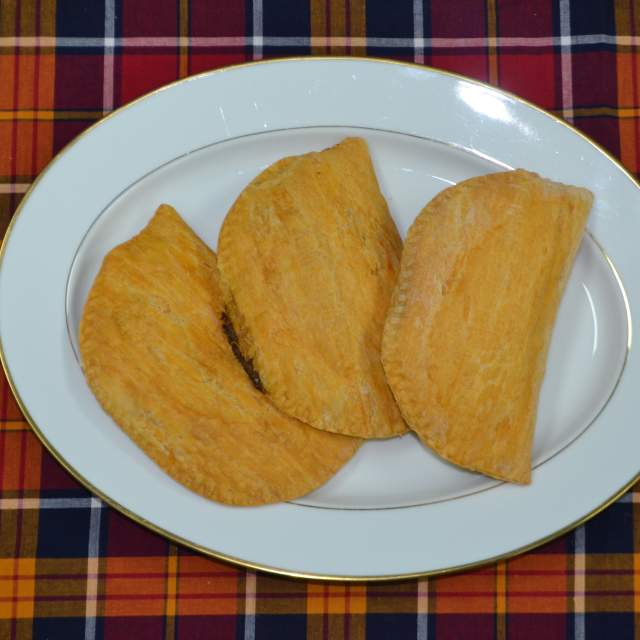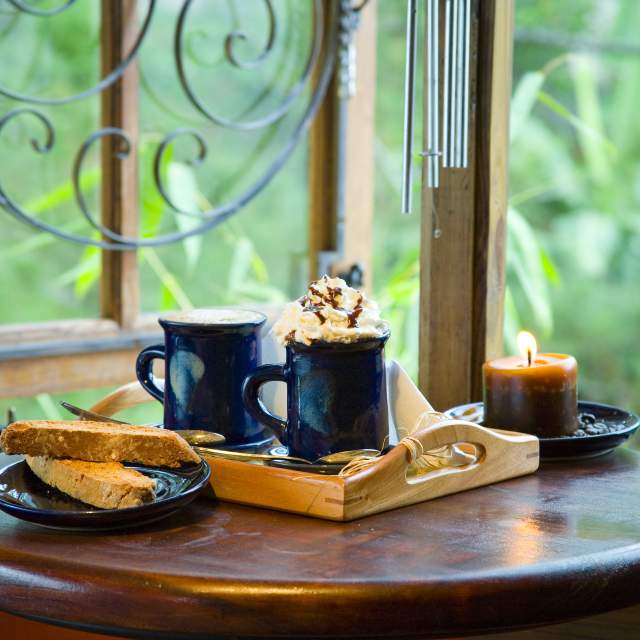Taste Jamaica
Come back to "Mmmmm!"
You owe it to yourself to explore the world of flavours that this island has to offer, from our famous street foods, to fine dining at some of our top restaurants where authentic Jamaican flavors and spices reflects the diverse cultural influences of our island heritage. Besides our signature blend of herbs and spices, Jamaican food is always made and seasoned with love, so you know it's always going to be delicious! We are proud of our world-famous culinary heritage and we can’t wait to share it with you so that you can come back to "Mmmmm!".
Jamaica’s national dish, Ackee and Saltfish, is a local breakfast favorite and a must try. Try it with all the trimmings - fried dumplings, calaloo, green bananas, avocado and plantains, depending on what's in season.
Spice it up!
Can't you tell? We love spicy foods! Jamaica is synonymous with all things jerk. Smoky, pimento wood flavoured jerk meats, seafood, and vegetarian dishes without a doubt takes pride of place at restaurants and food stands across the length and breadth of the island. Be careful when trying our beloved Scotch Bonnet peppers though. They are flavourful, but hot! Be sure to visit Scotchies in St. Ann, Sweetwood Jerk Joint or Pepper Thyme in Kingston, or Boston Bay in Portland for an authentic experience and cross delicious jerk off your bucket list of Jamaican foods to try.
Jamaica is an island blessed with an abundance of coastlines, from the azure waters of Montego Bay to the serene beaches of Negril, making Jamaica a seafood lover's paradise. Indulge in the catch of the day, from succulent lobster and shrimp to flavorful snapper and mahi-mahi expertly prepared with local spices and served with a side of fried bammy or festival. May we suggest fried fish and festival at Hellshire or steamed fish and okra and bammy for a deliciously authentic Jamaican dish? These are best enjoyed with your toes buried in the sand, a cold Red Stripe lager, and good company.
Come back to comforting
Jamaican food is hearty and comforting, like Jamaican favourites, curry goat, stewed peas and oxtail. In addition to traditional Jamaican food eateries serving delicious soups and stews, you will easily find Chinese, Indian and Syrian restaurants alongside an array of international cuisine options across the island. Come back to adventurous and explore the healing and aphrodisiac properties of common local foods like oysters, served raw in the half shell doused with a spicy vinegar sauce on the beach, roots drinks like peanut punch, or try mannish water spiked with white rum to get bragging rights, and one step closer to earning your "Jamaican Passport".
Ital is vital
Long before the vegan movement swept the world, "Ital" has been a diet practiced by Jamaican Rastafarians for vitality, energy, and life force. If you are vegan or a vegetarian foodie, you will have no shortage of fresh farm-to-table options to delight your bellies. Check out Zimbali Culinary Retreats in Negril or Stush in the Bush in St. Ann for an exclusive organic farm to table-to-table experience in a lush tropical countryside al fresco setting that will have you coming back to real food, and your best self.
Come back to delicious
Jamaicans love a sweet treat after a meal, don't you? Indulge your sweet tooth with specialty Jamaican sweets and traditional desserts like sweet potato pudding, cooked under a heap of hot coals. You know it's good when locals refer to these puddings as Hell a top, Hell a bottom, and Hallelujah in de middle! Be sure to stop in Priory, St. Ann at the Pudding Man (Jus Coool) for a slice of heaven.
Have we tempted your taste buds yet? Believe us, we could go on. There’s so much to taste here. It’s time for you to come back to delicious in Jamaica.
Puddin Man
The Jus Coool shop along the A1 highway in St. Ann is renown for old fashioned…
Home Grown Cuisine
Michelle and Suzanne Rousseau are sisters, restaurateurs and entrepreneurs putting…
Farm to Table
As the Executive Chef of the stylish Round Hill Hotel and Villas, Chef Martin…
From chicken to pork, lobster, and fish, there’s a jerk meal for just about any palate. Like the soft white sand of our beaches or the pulsating beats of reggae music, jerk cuisine is world famous. Jerk is both a method of cooking and a harmonious combination of spices originating with the Maroon people of Jamaica in the 1600’s. During the colonization of Jamaica by the British, the resilient runaway slaves known as the Maroons eluded the British by inhabiting the mountainous interior regions of Jamaica. To conceal their location they prepared meals underground, over coals and pimento wood, common to the hills of Jamaica.
Today this method of jerking meat is synonymous with Jamaica and transcends much of our local culinary scene. Be warned, however, the combination of sweet and savory spices mixed with fragrant wood is very hard to resist. You may find that your Jamaican diet consists of little else. Jerk is abundant on the island, from road-side vendors to jerk restaurants like Scotchies, or even your resort’s fine dining eateries. Pair it with any of our favorite sides like festivals, a fried sweet dough, or bammies, a cassava flatbread.
Ital cuisine is a natural method of preparing Jamaican food developed by Rastafarians in support of a healthy lifestyle. It involves no red meat and a celebration of the fresh fruits and vegetables that come straight from the earth. Typical of Ital cuisine is also the absence of salt as an additive to dishes, with flavors derived from a wealth of herbs and spices. Ital food is Jamaica’s take on vegetarian cuisine.
Deliciously savory filling encapsulated by golden pastry that flakes at the touch... that is the Jamaican patty. A derivative of the Cornish pasty, the Jamaican patty is a staple food and a must-try on any visit to Jamaica. These half-moon shaped delights are sold by patty shops and bakeries around the island, and though often had lunch, are eaten at any time of day due to their inexpensive price.
Major companies like Tastees, Juicy Patties, and Mothers have built an entire legacy around the humble patty, each with their own signature blend of spices and techniques. Sample them all and pick your favorite! Don't forget the patty's perfect companion, the cocoa bread. Shaped to fit, this soft sweet bread pairs beautifully with a fresh-from-the-oven patty, a match made first in Jamaica.
Our desserts are as sweet as reggae music! Here are a few to try during your visit:
Grater cake - This sweet treat is made from shredded coconut, sugar and food coloring and is often referred to as Pink on Top.
Gizzada - Also known as Pinch Me Round because of its crimped pastry, gizzadas are a combination of the earthy flavor of nutmeg with sugar and coconut, atop a light buttery pastry.
Jackass corn - Jackass Corn is a sweet thin biscuit known for its primary characteristic, it’s tough as nails! Take a hard bite and you’ll discover this treat to be a delight/delightful.
Blue drawers/Tie A Leaf/Dukunu - Green bananas, sweet potatoes and coconut make up this boiled pudding, wrapped in banana leaves to preserve its shape and give flavor.
Tamarind balls - The tartness of tamarind covered/rolled in sugar. A delicious and quite sweet confection easily found from supermarkets to gas stations and even in exotic flavors like coffee and ginger.
Busta - This dark hard candy, a mix of coconut and wet sugar, is said to be named after Jamaica’s first Prime Minister, the Hon. Alexander Bustamante.
Chocolate tea - No powdered or packaged cocoa can compare to a cup of Jamaican chocolate tea. This soothing drink is traditionally prepared steeping grated chocolate balls with milk and spices. The perfect way to end the day.
In Jamaica, we’re lucky. As a tropical island with a beautiful climate all year round, we have hundreds of exotic fruits and vegetables to choose from. From mangos and bananas to our national fruit ackee - we're spoiled by Mother Nature herself.
With a large variety of fresh fruits and vegetables that grow all year round, Jamaica is ideal for healthy eaters. Indulge in our exotic delights. As you travel the island, here are some fruits and vegetables you might recognize:
Ackee: Our very own national fruit ackee, is not only a good source of protein but truly delicious. It is essential to wait until the pod has opened before eating it, otherwise, the results aren’t totally pleasurable.
Breadfruit: One of the most versatile and delicious fruits around, the exotic breadfruit actually tastes of bread. Whether you roast or boil it, you’ll enjoy a potato-like consistency and sweet taste.
Callaloo: A breakfast staple, callaloo is a very nutritious plant, noted as a rich source of vitamins and minerals. This leafy vegetable is commonly served steamed and tastes similar to that of spinach, but not quite as bitter.
Cho Cho (Chayote): Not the typical fruit, the cho cho is best enjoyed in savory dishes such as soups and stews. This pear-shaped fruit is found rather bland when raw but tastes like a cross between a cucumber and potato when cooked.
Guinep: Guineps appear as a cluster of drupes (similar to grapes), with a thin layer of green skin which, when bitten, reveals an orange-hued gelatin flesh. The tart like taste is quite addictive, so don’t be surprised if you find yourself consuming the whole bunch! Be careful though, the juice from this fruit can cause stains.
June Plum: A wonderful source of iron and protein, the June Plum is both juicy and sour. Sometimes a dash of salt is used to give the fruit an explosive flavor.
Jamaican Coco: A treat in soups and breads, the Jamaican coco has a creamy, comforting taste. With big spade-shaped leaves, it takes close to a year to mature. But we think it’s worth it.
Otaheite Apple (Cocoplum): The refreshing, Otaheite apple is a burst of balanced sweetness. Its deep crimson red skin coats its crisp white flesh, in a pear-like shape. This fruit is noted as being a good way to hydrate and has even been used for treating diabetes and other maladies.
Star Apple: This luscious fruit appears in variations of dark purple to green with a soft pulp flesh core. Jamaicans often refer to the star apple as the “mean” fruit as they never fall from their stems even after they’ve ripened. Still, the star apple offers a generous helping of sweet satisfaction, though you should try to avoid the skin as it can be rather bitter. The pulp was traditionally used with sweetened milk to make a dessert called ‘matrimony’.
Stinking Toe: This rather peculiar fruit gets its name from its semblance to a big fat toe. Its accompanying odor may make you hesitant; however, the large seed pod actually houses a delicious, sweet but mealy pulp. Found on one of the largest trees in the Caribbean, ‘Tinking Toe’ is also used in folk medicine to alleviate headaches and rheumatism.
Susumber (Gully beans): these small bitter-tasting green berries are very popular in Jamaican cuisine. Some persons enjoy their susumber with the national dish, Ackee and Saltfish (salted codfish) or in stews and soups. Susumber is said to be rich in iron and the leaves have been used to make tea as a remedy for colds.
Sweetsop: Nestled inside the lumpy green outer-layer of this fruit is an aromatic and sweet custard-like pulp. The sweetsop is a very good dessert or breakfast fruit and is an excellent source of vitamin C and manganese.
Citrus Fruits
Ortanique: A cross between a tangerine and orange, the Ortanique is a seedless and exceptionally juicy citrus grown in Jamaica. This natural tangor can be enjoyed straight from the tree or in salads and juices. It’s very distinct rare flavor can be enjoyed between February and April.
Sour Orange: Also known as bitter or Seville orange, this citrus is usually enjoyed by locals as an alternative to lemons and makes refreshing lemonade. Though many have found the fruit too unpalatable to be consumed straight from the tree, the sour orange is very useful for making marmalade and flavoring for baking, cooking and even liqueur.
Tangerine: The second best thing about a Jamaican tangerine is how easily they can be peeled. The first would have to be the delicious sweet flesh you’ll come to discover. The carpals (sections) come apart with ease, making the feasting of this fruit even more gratifying. Best enjoyed freshly picked, they can also be added to salads or desserts for a sweet and tarty zest.
Uniq (Ugli Fruit): Indigenous to Jamaica, the ugli or uniq fruit is an exotic tangelo available between November and April. Although the name may not sound appetizing, this citrus fruit is quite a juicy indulgence. Said to be created by the hybridizing of a tangerine, orange, and grapefruit (pomelo), it is sweet and tangy, perfect for refreshing juices.




